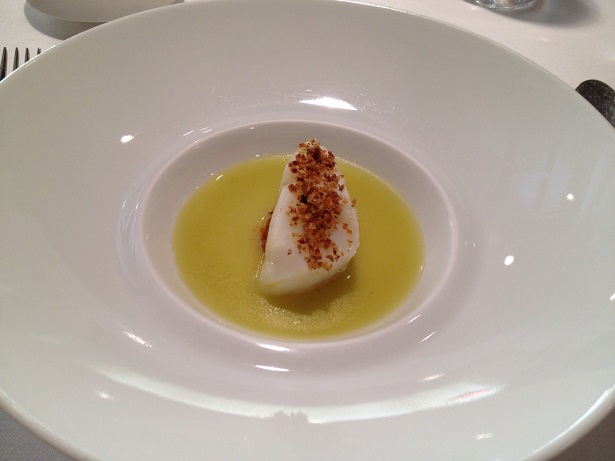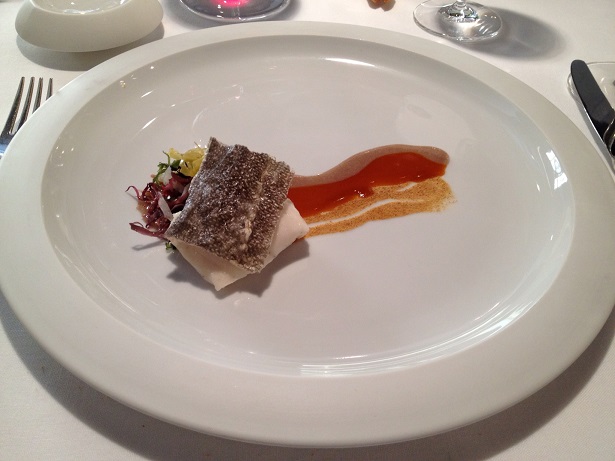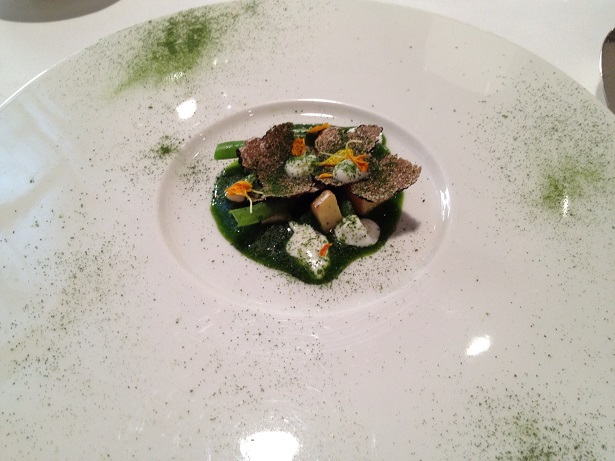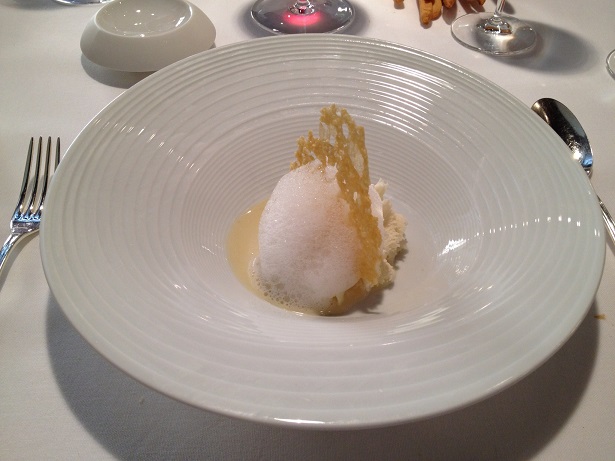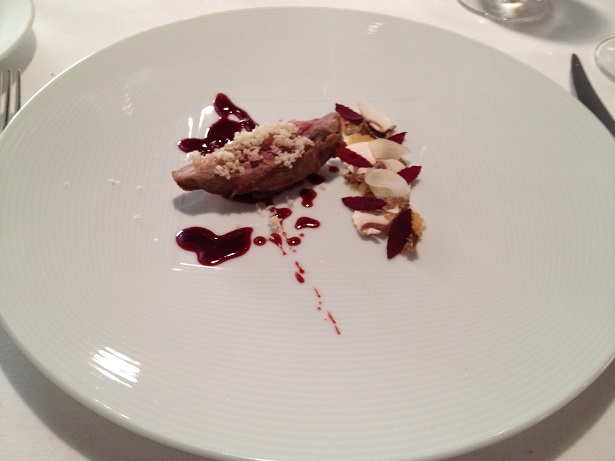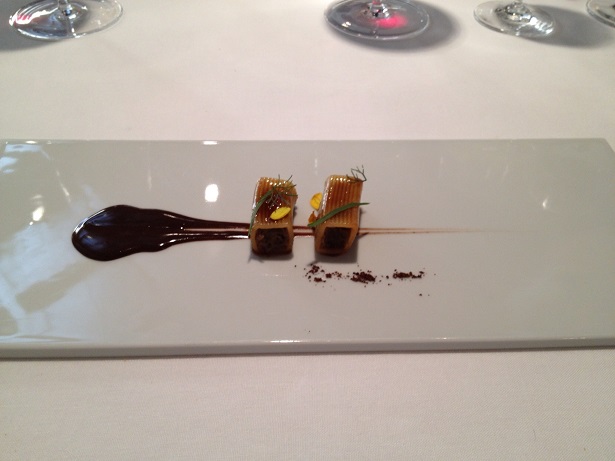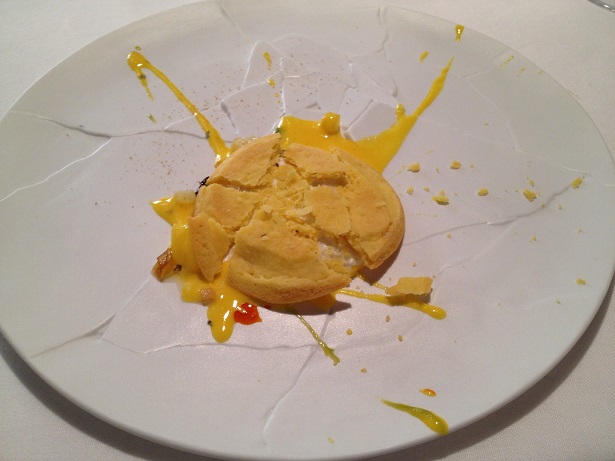Browse using the new Vinous website now. Launch →
Printed by, and for the sole use of . All rights reserved © 2015 Vinous Media
Via Stella, 22
Modena, Italy
Tel. +1 39 059 201 118
reserve@osteriafrancescana.it
Wine:
2010 Borgo del Tiglio Studio di Bianco 94
2010 Serragghia Zibibbo 92
2006 San Giusto a Rentennano Percarlo 99
Osteria Francescana and Proprietor/Chef Massimo Bottura continue to rack up an impressive series of recognitions and awards. I first tasted Bottura’s cuisine a few years ago at a gala event in New York City. A group of the finest Italian and American chefs teamed up to prepare a multi-course dinner for a large number of people. I don’t remember how many, but a lot. Bottura’s fish course (similar to the cod below) was simply extraordinary. His ability to execute that dish in a tiny kitchen was remarkable, especially since most chefs make far safer choices in those situations. I was hooked.
Despite
its informal sounding name, Osteria Francescana is anything but that. Widely
recognized as one of the world’s top restaurants, Osteria Francescana is the
backdrop for Bottura’s innovative, cutting-edge cuisine. The sleek, modern
dining room comes as a bit of a shock at first, but its virtues become
increasingly apparent over time. A minimalist aesthetic puts food front and
center. With just twelve tables, Osteria Francescana offers a level of intimacy
that is practically inconceivable in big city terms. Bottura himself makes the
rounds a few times during service, explaining his creations and adding a
personal touch that is rarely possible in a day and age when chefs are
virtually required to manage global empires.
Massimo
Bottura’s resume includes apprenticeships with Alain Ducasse and Ferran Adrià. Despite
his international pedigree, Bottura is very much a man of Modena, something
that is evident as he talks about some of his true passions, including the
artisan side of Parmiggiano Reggiano, balsamic vinegar and other local
specialties. Many of the dishes are driven by incredibly concentrated reductions
of key flavors and essences. Playful, whimsical, challenging and remarkably
pure at the same time, this is cooking that will challenge all of the senses.
Osteria Francescana offers three tasting menus: Traditions and Classics, plus
Sensations, which is the most adventurous and the choice that inspired us on
this day.
General
Manager and Wine Director Giuseppe Palmieri oversees an extensive wine and
spirits program. The wine list is ambitious and fairly complete by Italian
standards, but not quite at the level of similar restaurants around the world.
To be fair, though, I am not sure what a realistic expectation should be for a
30-seat restaurant in a medium-sized Italian city. On the plus side, diners
will find many reasonably priced wines, including treasures from some of
Italy’s top producers. Personally, when the food is this adventurous I prefer
to keep wine on the simple side. I see quite a few dishes at other tables being
paired with spirits, though, and my curiosity is piqued more than once.
We
start with the 2010 Studio di Bianco
from Borgo del Tiglio, one of my
favorite Friulian producers. A blend Friulano, Sauvignon and Riesling, the 2010
has a gorgeous combination of aromatics, fruit and acidity. It’s always a
gamble to choose a wine without knowing exactly what you are going to eat.
Thankfully, the 2010 Studio di Bianco works beautifully with our first few
courses.
Palmieri
suggests the 2010 Serragghia Zibibbo,
a Sicilian wine I have never heard of. It turns out to be one the most exciting
and unique wines of the year. Zibibbo, an indigenous Sicilian grape, is usually
seen in dessert wines, but here it is fermented dry with some contact on the
skins. An eccentric, layered white, the 2010 is the vinous equivalent of
Bottura’s food. Sweet, salty, floral and intensely influenced by its Sicilian
roots, the 2010 Zibibbo is like the almond granita at the beginning of the
lunch; an experience of near sensory overload. What a gorgeous wine.
I
have always adored San Giusto a
Rentennano’s 2006 Percarlo, a wine I bought heavily as 2006 is my son’s
birth year. Is the 2006 ready? Of course not, but after a gentle decant it is
gorgeous with this menu. It is an especially good match for the pigeon and
quadrotto. The bright Sangiovese acidity in particular seems to literally carry
the flavors across the palate, giving them lift and an additional sense of
energy.
Our
tasting menu is full of highlights, but these are some of the true standouts:
A
starter of almond granita, capers, coffee cream and bergamot is the perfect
introduction to the Bottura style. Salty and sweet flavors play off the palate,
all enhanced by an intriguing combination of textures. The Cod fillet with a
super-concentrated Verdute olive juice, tomato broth, Noto almonds and scents
of Pantelleria expresses many of the Bottura signatures, most notably the
search for intensity of flavor.
I
love the Spaghetti alla Chitarra cooked in scorched squid broth. A generous
dollop of caviar adds a playful exuberance to a pasta dish that captures the
essence of the sea. The crispy and tender branzino in a rabbit cacciatore sauce
is another highlight. Here Bottura combines the delicate fish with a powerful,
earthy rabbit cacciatore sauce. In case you’re wondering, the crisp piece of
branzino skin is delicious.
A
tribute to Normandy, which turns out to be lamb tartare topped with mint and served
in oyster shell, is one of the more abstract creations on this menu. It is delicious
and refreshing.
Fresh vegetables, black truffles and that morning’s Parmesan whey are transformed into Think Green.
Bottura’s
signature Five Ages of Parmiggiano Reggiano in Different Textures and Temperatures
is a culinary tour-de-force, and I do not use that term lightly. Here, in the
heart of its production zone, Parmiggiano Reggiano is elevated to lofty
heights. It’s hard to do this dish justice with words. We are eating not just
food, but history and culture as expressed through a local cheese that carries
with it far more complexities than most people realize. The centerpiece is a soufflé,
but the accompanying crisp, foam and sauce are a revelation, to say the least. In
the US, we walk into a store and buy “Parmiggiano Reggiano.” The most demanding
consumer might inquire as to the age of the cheese. But that’s pretty much it.
The reality is that in cheese, as in wine, there are a handful of artisans
whose product is vastly different in quality from what comes out of the big facilities.
Buying cheese without knowing who made it and specifically where it is from is
like buying a wine, say ‘Chianti Classico’ or ‘Chambolle-Musigny’ without
knowing the producer, unthinkable for wine.
A
pigeon course follows. It is cooked perfectly, while the accompanying
vegetables add brightness and lift. The quadrotto pen and feather is two
rigatoni-shaped pasta tubes filled with a game ragu. A rich sweet/savory
chocolate binds all the elements with supreme grace. This is another head
spinning dish that challenges conventional assumptions left and right. Is it a
pasta or main course? Or maybe dessert? I am not sure, but it is delicious. Basil: from Liguria to the Gulf of Naples, an
example of Bottura’s maniacal search for the very finest raw materials and
highlights just how different those ingredients can be, even within just the Italian
peninsula.
Oops!
A fallen tart, another Bottura signature, is a nod to homemade comfort food and
arguably the most conventional item on the menu. It is also a nice return back
to Earth after
a series of celestial dishes that challenge the mind, palate and intellect.
Food:
– Almond granita, capers, coffee cream and bergamot (Not pictured)
– Razor clams and their friends
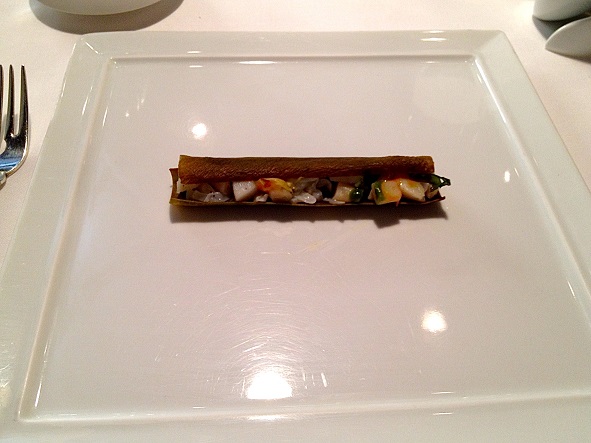
– Baccala Mare Nostrum: Cod fillet, Verdute olive juice, tomato broth, Noto almonds and scents of Pantelleria
– Spaghetti alla Chitarra cooked in scorched squid broth, whipped with a puree of Fine de Claires oysters and extra virgin olive oil
– Crispy and tender Branzino in a rabbit cacciatore sauce
– A tribute to Normandy
– Think Green
– Five ages of Parmigiano in different textures and temperatures
– Pigeon casserole, mineral and acid salad with balsamic vinegar
– Quadrotto pen and feather
– Basil: from Liguria to the Gulf of Naples (Not pictured)
– Globe light as a flower
–
Oops! A fallen tart
-- Antonio Galloni

